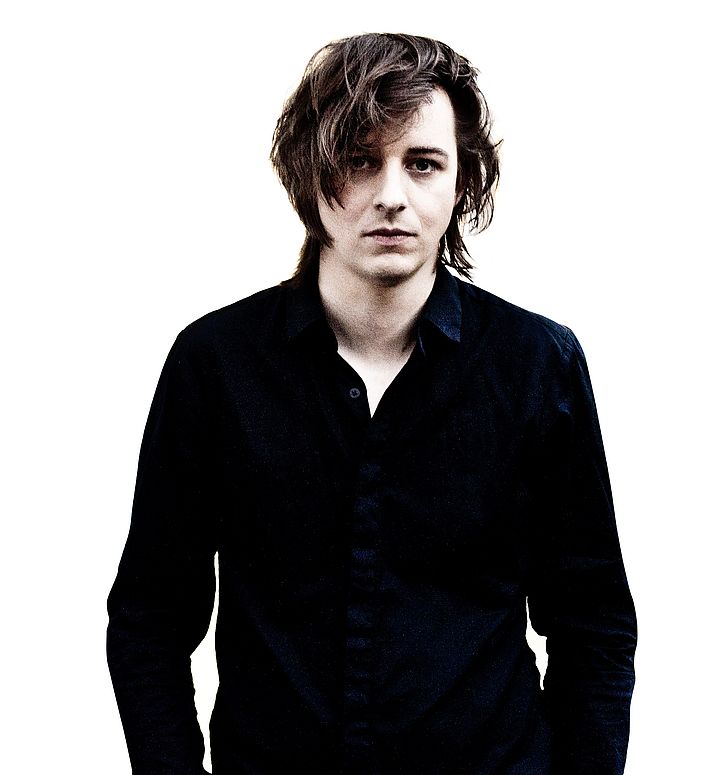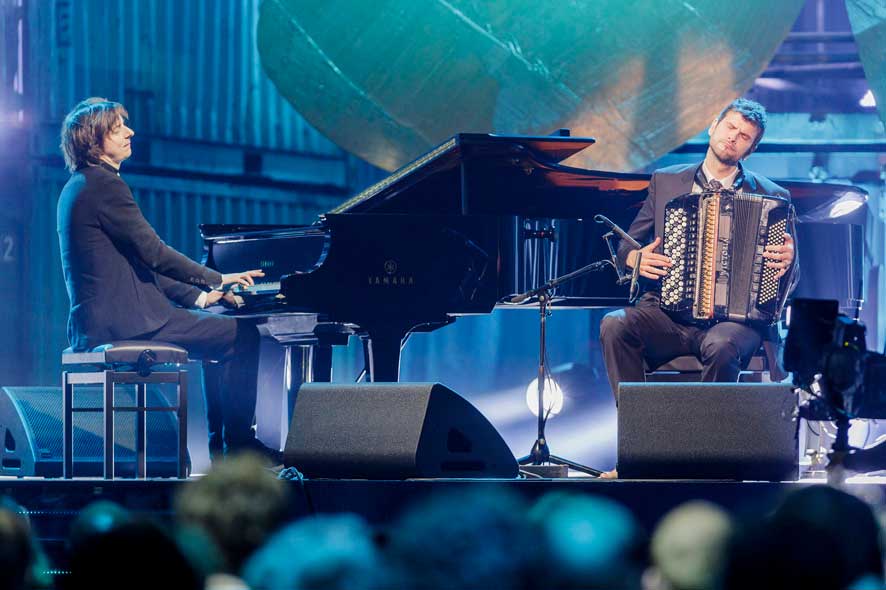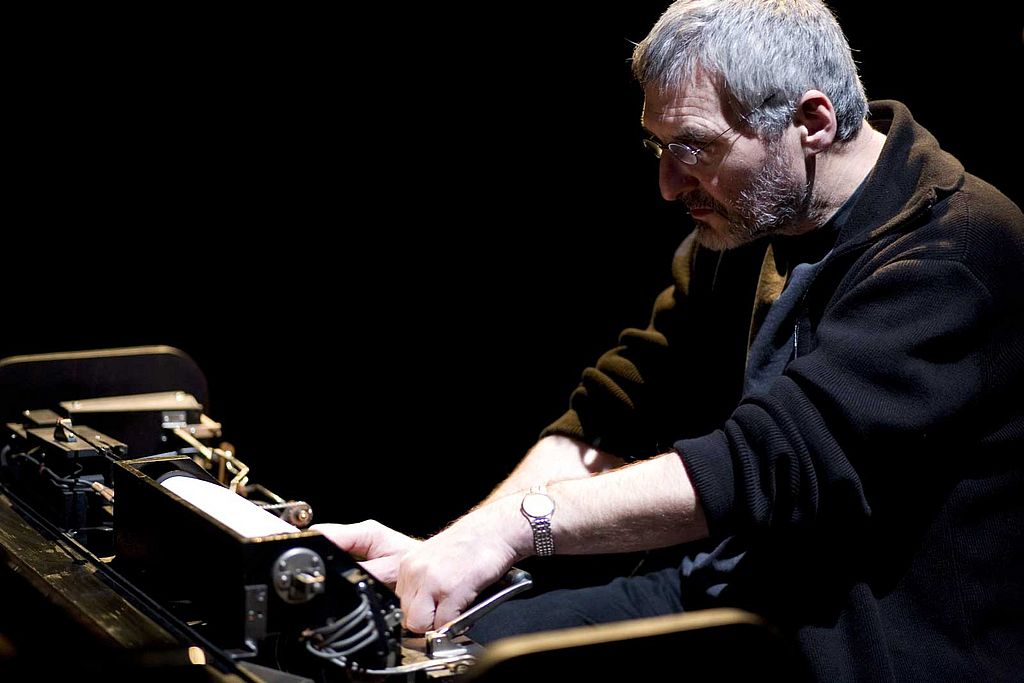Battling the Black Hand
A conversation with Michael Wollny on the creation process for the music for Bauhaus 100 – and the essence of truly soulful art.
By Oliver Uschmann

Mr Wollny, we’re meeting here right in the middle of your work on the composition that you will perform in January when the Bauhaus anniversary commences. So how is it going?
I’m oscillating between enthusiasm and desperation (laughs). In my mind’s eye I first had a feel for the approach to the design, but I also felt something haptic between my fingers. There is a connection with the Bauhaus. My wife once danced a variation of Oskar Schlemmer’s Triadic Ballet in Dessau. And of course, I’ve really been interested in the spirit of the school for a long, long time –in the cooperation between all disciplines.
Was there musicology at the Bauhaus?
I don’t know of any classical music theory at the Bauhaus, but of course there was what were known as “harmony classes”. Gertrud Grunow was hard at work on the relationship between colour, sound and movement. “Dance the colour blue!” was a feared order among the students (laughs). But there wasn’t any school of composition, although all those that I now read about have always emphasised their close personal relationship with the music.
With which exactly?
On one hand there was an enthusiasm for styles, which were strictly structured and followed specific construction principles. Before that particular time therefore the baroque, and in the present of that time the twelve tone music, especially in the person and theory of Josef Maria Hauer, who in historical terms had already developed his own form of twelve tone music, even before Schönberg. On the other hand there were the famous Bauhaus nights, at which some really wild music was played. The supremely popular Bauhaus Orchestra and its dance music, played with self-made as well as regular instruments, symbolised this.
The press of the day spoke, not without irritation, of a “rhythmic delirium”.
The main thing was to go into some kind of trance. I can imagine how melodies dissipate and textures provide space. A kind of ecstatic minimal music. The bottom line here is the state of tension between structure and freedom of form. As at the Bauhaus itself. On one hand the strict, the constructed. On the other hand the joint experiment. The professors were called “masters”. Their experience of course gave them authority, but they worked in the workshops and studios with their students on an equal footing.
If the joint experimenting at the Bauhaus was critical, the jazz colleagues would have to follow suit here up in their loft.
That’s already happened. Leafcutter John, who includes everyday sounds and alternative control forms of musical events in his music, was here not long ago. I asked him earlier: “What sounds come to mind when you think about the Bauhaus?” I’ll show you his answer if you like (opens Messenger on his mobile phone): “I think of form and structure. Gropius reminds me of the synthesizer sounds of the 80s. Recursivity. Simple forms, frequently repeated, scaled and rotating, to make more complex structures out of them again. With Paul Klee, I think more about warmer textures, he plays in my head in analogue.” We did a jam session with ideas and sounds instead of instruments. This produced the concept of pursuing sound generation with materials, which were typical for the Bauhaus at the time.
Leafcutter John won’t be the only colleague you’ve brought in.
No, my first thoughts were for Wolfgang Heisig, a Phonola expert. The Phonola is a mechanical device operated with punch card rolls. You place it above the piano keyboard, drive it with foot pedals, and its levers press the piano keys according to the holes in the punch card roll. The set-up: two grand pianos on the stage. I sit at one, the machine sits at the other and plays new compositions, which I’ve written here and which Wolfgang has then punched into the punch cards in the workshop.

This arrangement embodies the spirit of the Bauhaus, which we mentioned at the beginning. The simultaneity of strict construction and investigative spontaneity.
That’s the idea. My part on the grand piano is wild and organic, the parallel running punch card composition is unstoppable and unchangeable. At the same time the device’s age also allows us to relive the 20s.It is mechanical, but not digital.
Anyone else in the team?
The fourth man is my fine label colleague at ACT Music, soprano saxophonist Émile Parisien. Émile is a virtuoso improviser, and he also embodies the condition of absolute ecstasy when playing and therefore most powerfully portrays one end of the two poles, with the piano machine being its counterpart. That would be the core quartet for the evening. With Max Stadtfeld, of course, we also have a drummer that I’ve personally experienced as an enormous talent in his time at the Leipziger Musikhochschule.
That sounds very well considered, with desperation nowhere to be seen. How many of the thick books there on your desk have you already ploughed through?
I always read in wild confusion. The longest resident on my shelves of course is the wonderful “Essays über Kunst und Künstler” by Kandinsky. These texts are very specific and instructive, but at the same time have a charged language that fascinates me. Here for example: “Every art has its own language, i.e., resources for it alone. So every art is somewhat self-contained within itself. Every art is its own life. It is rich for itself. The indefinable and yet specific spiritual process (vibration) is the goal of the individual artistic devices. A specific complex of the vibrations – the goal of the piece.”
Put quite simply, you could say: A truly soulful piece has a “vibe”, which cannot be conceptualised.
Hartmut Rosa calls this “resonance”. His is another book that currently really thrills me. It tackles the question as to whether one works more resource-oriented or more process-oriented. Right at the outset Rosa provides the example of two talented young artists, who must create an image in two weeks. One methodically collects the material, repeats the most important techniques and goes searching to a theme. He works resource-oriented. The other tears a piece of paper from their notepad, simply begins and loses themselves in a world that appears harmonious to him.
Resources and technique are necessary, but does the soul of a piece come from the process?
The inspiration, the creativity remains a secret. Kandinsky has a very poetic image for this (turns pages). He says: “The positive, the creative, the good, the fertilising white ray.” So, and now we get to it. The white ray has an opponent, a force that works against it –the “black hand”.
That sounds ominous.
I quote: “A black hand is placed over the eyes. People are blinded. The Black Hand is that of the hater. The hater tries with all their might to stop evolution and elevation. The negative, the destructive, the bad. That is the black, pestilent hand.” Instead of hate one could perhaps also simply say “fear”.
Pop music is full of purely “resource-oriented” constructed hits. Jazz, however, essentially represents freedom. Or is the Black Hand also at work here?
We give ourselves a clip round the ear with the Black Hand when we do battle with it, despite all experience in writing new music, to preserve the old innocence. I know of cognitive states in which all cadences already resonate with every note.
The Bauhaus essentially found the solution for this problem. Just as you now address the performance with John, Wolfgang, Max and Emile.
On 16 January there will be something to hear here, whose individual elements we can define rationally in retrospect, but not now already, in the process. It is impossible to think about it from the other end.
